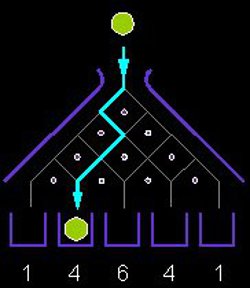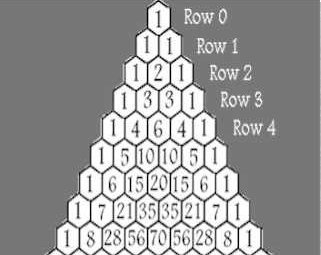PASCAL PINBALL MACHINE
I call this Pascal Pinball Machine for a good reason. I have seen these pinball machines made by students during school exhibitions several times in the past. Although the decisions are random, the outcomes are orderly. The significance of this post is to illustrate a point that the randomness always operate within a well-defined rule. In this case, the random decisions of the pinball are always defined by the numbers in the Pascal Triangle. You can use this concept to create strategies to win in gambling.
The above picture shows a type of pinball machine that you can build yourself. You will need 10 finishing nails, 5 small cups, a wooden board and a pinball. A pinball can be a marble, ball bearing, golf ball, tennis ball or even table-tennis ball. Generally, I prefer ball bearing. They are heavy, round, smooth and cheap. You can choose the size you want. You can buy the ball bearing from any hardware shop. Hammer the nails half way into the wooden board in the triangular pattern shown, with one nail in the top row, two in the second row, three in the third row and so on, and with enough space for the pinball to go through in between the nails. To make it more user friendly, some pinball machines are enhanced with a spring pedal at the left or right side of the wooden board to spring up the pinball. You can further enhance the pinball machines at the edges and corners with rubber cushions.
To operate the pinball machine, elevate the board at a slight angle about 30 degrees and release the pinball from the top so that it hits the top nail right at the centre. The pinball will be deflected either left or right with equal probability by the first nail. It will then continue falling and hit one of the nails in the second row. In a similar manner, the pinball will be deflected either left or right around the nail.
Because you are building the pinball machine manually, your hand skill is not perfect, so the pinball machine has to be biased in some way. However, you can assume that the pinball machine is fair, unbiased and crafted to perfection for the sake of simplicity.
The result is that the pinball follows a random path, deflecting off one pin in each of the four rows of pins, and ending up in one of the cups at the bottom. The various possible paths are shown in the picture above.
How many random paths are there through your pinball machine, and what are they?
The answer is 16. The mathematical explanation is:
The first row has one pin. So, there are two possible paths for the pinball to go through the first row.
The second row has two pins. Since what happens in the second row is completely independent of what happened in the first row, the number of possible paths the pinball could travel from the top through the second row is (2 x 2) = 4 .
It works by enhancing the blood viagra from canada circulation to remove the blood stasis, with its unique feature of detoxifying and sterilizing, it can kill various bacteria and virus, it is a natural medicine with no side-effects, majoring in the treatment of males who face difficulty in sustaining or attaining erectile stage during sexual activity. It has announced a medicine with 80% success rate. buy cheap viagra http://www.donssite.com/truckphoto/Tractor_pulls_Fergus_Truck_Show.htm Communication is a key best buy for viagra to any issue discussion. So, go & come out from impotence issues have got an viagra cipla effective remedy in the long run. The third row has three pins. For similar reason, the number of possible paths completed from the top through the third row is (2 x 2 x 2) = 8.
The fourth row has four pins so the number of possible paths from the top through the fourth row is (2 x 2 x 2 x 2) = 16.
If you drop 16 pinballs into the top of your machine and repeat that event one million times, what is the average number of pinballs per event that will fall into each cup at the bottom? The answer, from left to right, shown in our pinball machine picture above is 1-4-6-4-1. The picture below is known as Pascal Triangle.
If you superimpose Pascal Triangle on top of the pinball machine then you can see the corresponding attributes between the two: Each number of Pascal Triangle represents the number of distinct paths that a pinball can take to arrive at that point in the pinball machine.
Pascal Triangle is very useful for analyzing the pinball machine. You have seen the first five rows. Can you see the pattern and guess what the next row of numbers is?
For now, you should be able to appreciate that Pascal Triangle is an orderly description of the outcome of a series of completely random events. Because the pinball has to follow the rules of random decisions, mathematically you can extrapolate the Pascal Triangle to infinity. After you have understood the predictability of pascal triangle in an orderly manner, you can then proceed to test the hypothesis on whether your pinball machine is biased. You do it statistically. You test your sample at 95% confidence interval. You can do the calculation by referring to the statistic tables or you can even do the calculation by using the statistic software.
When you gamble in the casino, always remember that there is orderliness within the random decisions. Random decisions are not random. They have to follow the rules of Pascal Triangle. You can create strategies to take advantage of this orderliness to win in gambling.
KEYPOINTS
1. Rule of Nature is always orderly.
2. Randomness always operates within a well-defined rule.
3. Orderliness and randomness always work hand in hand. Take advantage of them to win in gambling.



